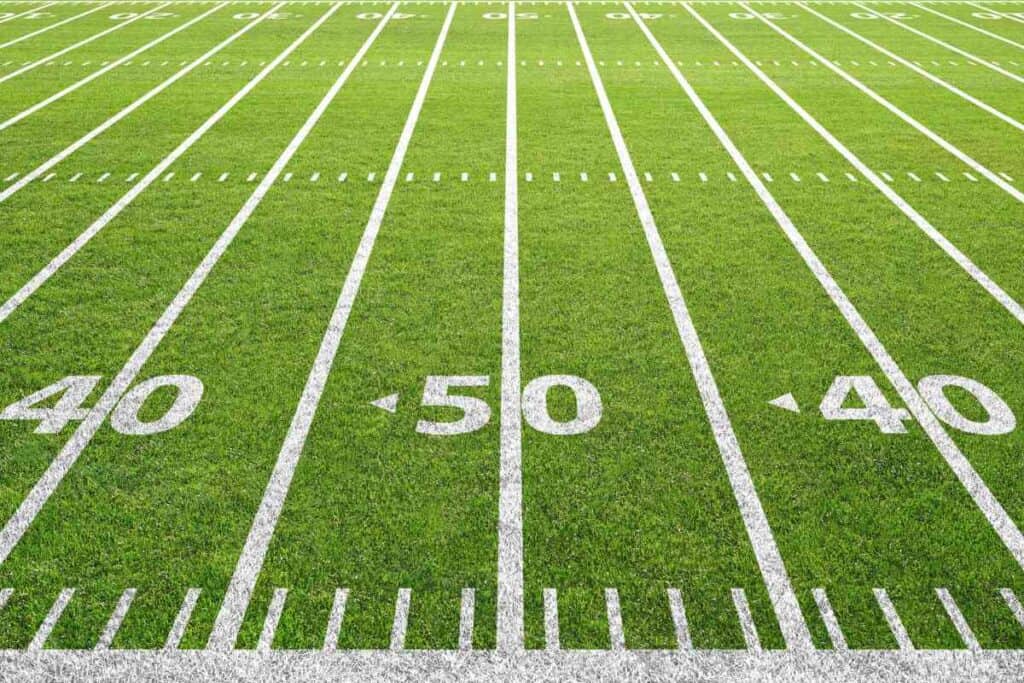Size Matters: Are College Football Fields Bigger Than High School Ones?
Football fields are supposed to be uniformly the same size across all levels of play. But are college football fields bigger than high school fields?

Are College Football Fields Bigger Than High School Ones?
No, there is no difference in the size of college and high school football fields. Each field is 100 yards long with two 10-yard end zones totaling the length at 120 yards. Both fields are 53 ½ yards wide.
I’m a sports enthusiast who has been practicing and playing sports for well over 20 years. I have stepped on many different types of fields, including high school football fields and college football fields.
I can tell you without a doubt, that there is no difference in size between the two football fields.
Football Field Size
Every football field has the same size no matter what level you play at whether it be high school football, college football, or professional football.
Each football yard length is supposed to be exactly 100 yards long with an end zone at each end measuring at 10 yards.
With the two end zones attached, each football field measures a total of 120 yards in length.
The football field width is roughly half of the designated play area. That is, the width of a football field is 53 ½ yards wide.
These dimensions make for a nice squared rectangle. These dimensions are the same for all three levels of football: high school, college, and professional.

Each 5 yard length of the field is designated by a five yard mark, but only every 10th yard is delineated by a number.
The marks start at 0 and work their way up to the 50 yard line, and then start descending back down to 0. For example, the yard hashes mark 0,10, 20, 30, 40, 50, then start descending down to 0 like 40, 30, 20, 10, 0.
Walter Camp is credited with creating what is considered the modern American football field.
During the early years of football, the rules still followed a mix between Rugby and Soccer. The game was considered so violent, that the game was banned from being played in any public forum such as streets and parks.
Later, Camp created the field so players could continue playing Football without breaking the law. Football has been since around 1869.
The first American game that was recorded being played was Rutgers University and Princeton University.
In the years following the first recorded game, various rules were introduced such as the line of scrimmage rule, the down and distance system, and the legalization of the forward pass.
Differences Between Levels
There are some differences between the fields of high school and college football. For example, one difference is the set of hash marks.
Hash marks on the field decide where the play will start laterally on the field. For example, if the play ended on the right side line, the next play will start on the right hash mark of the field.
The length of these hash marks across the field are a major difference between high school and college football. For example, in a high school football field, the hash marks will be 53 feet and 4 inches away from the sideline. That’s 17 yards aways from the sideline. In college football, the hash marks are 40 feet apart.

These hash marks can become important for the game since field goals are often kicked from the hash marks.
A field goal kicked from 50 yards out will differ if it’s from the center hashmark or the right hashmark, especially at the high school level since kickers are inexperienced and have legs that don’t stretch as far.
Hash marks make a bigger deal at the high school level as well since the stadiums aren’t as big, and players get close to each of the side lines.
High school football hash marks are a big deal as well because they add yardage to the game.
For example, a running play that starts at the right hash mark and goes into the left side of the football field will add substantial yardage to the play, which will be more difficult for a high school level player to complete since they are shorter.
Other Differences Between College And High School Football Fields
Size and the sets of hash marks aren’t the only difference between the two football fields.
There are a couple other differences between the playing field of college and high school football.

One difference is the goal post. The standard football goal post is 10 feet high with each prong launching an additional 20 feet high into the sky, totalling a 30 foot high structure.
But the difference of the width of the prongs differs for college fields and high school fields.
High school football goal posts have a width of 23 feet and 4 inches wide while NCAA goal posts have a width of 18 feet and 6 inches wide.
On professional football fields, you can see the football goal posts are exactly the same size as college football goal posts.
The lighting on the fields would also be different. The lighting on a high school football field may be substantial, but won’t be anywhere near that of a college football field.
This is usually because college football fields are backed by a university’s purse whereas just the local high school backs high school football fields.
College football fields draw more of a crowd than high school football fields so more money and resources are spent building and maintaining college football fields rather than high school football fields.
Another difference is the surface of the playing field. Typically, football field dimensions for high school are usually filled with natural grass or a combination of grass and artificial turf while college football field dimensions are filled with artificial turf.

That’s not to say every field is like this, just like every field in the National Football League isn’t artificial turf. But the majority operate this way.
Lastly, the seating capacity is the main difference between college stadiums and high school stadiums.
The largest football stadium for the high school level is called the Mesquite’s Memorial Stadium and seats 19,000 people whereas the largest college football stadium, the Michigan Stadium, seats 107,000 people.
There really is no comparison between high school and college football stadium seating, as college football stadium seating is consistently much larger than high school stadium seating.
Related Reading
- Are high school football fields smaller than the NFL?
- What Size Is a High School Football Field?
- Why are college football stadiums bigger?
- What type of grades do you need to play high school football
- Does College Football Get Bigger Crowds Than The NFL? Why?
- NCAA Vs. NFL: Is College Or Professional Football Bigger?
- Why Are College Football Championships On Mondays?
- Can high school football players get paid?
Key Takeaways
- There is no difference in football field sizes between college and highschool football.
- Hash marks are set different distances apart on college and high school football fields.
- Goal posts differ in size between college and highschool football fields.
- Stadium sizes are much different, with college stadiums having lots more seating.
- Lighting and surface conditions also vary greatly between both fields.
